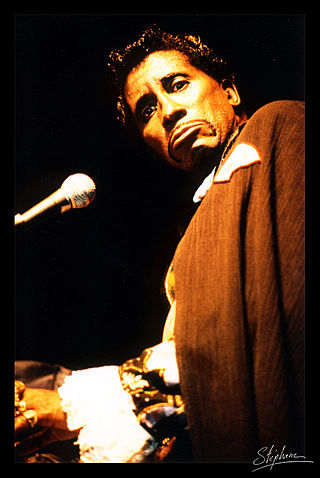
Jalacy J. "Screamin' Jay" Hawkins was an American singer-songwriter, musician, actor, film producer, and boxer. Famed chiefly for his powerful, operatic vocal delivery and wildly theatrical performances of songs such as "I Put a Spell on You", he sometimes used macabre props onstage, making him an early pioneer of shock rock. He received a nomination for the Independent Spirit Award for Best Supporting Male for his performance in the 1989 indie film Mystery Train.

Eurythmics were a British pop duo formed in 1980, consisting of Scottish vocalist Annie Lennox and English musician and producer Dave Stewart. They were both previously in the Tourists, a band that broke up in 1980. They released their first studio album, In the Garden, in 1981 to little success, but achieved global acclaim with their second album, Sweet Dreams (1983). The title track became a worldwide hit, reaching number two in the UK Singles Chart, and number one in Canada and the US Billboard Hot 100. Eurythmics went on to release a string of hit singles and albums, including "Love Is a Stranger", "There Must Be an Angel " and "Here Comes the Rain Again", before splitting in 1990.

Ann Lennox is a Scottish singer-songwriter, political activist and philanthropist. After achieving moderate success in the late 1970s as part of the new wave band the Tourists, she and fellow musician Dave Stewart went on to achieve international success in the 1980s as Eurythmics. Appearing in the 1983 music video for "Sweet Dreams " with orange cropped hair and wearing a man's lounge suit, the BBC wrote, "all eyes were on Annie Lennox, the singer whose powerful androgynous look defied the male gaze". Subsequent hits with Eurythmics include "There Must Be an Angel ", "Love Is a Stranger" and "Here Comes the Rain Again".

Alan Price is an English musician who first found prominence as the original keyboardist of the English rock band the Animals. He left the band in 1965 to form the Alan Price Set; his hit singles with and without the group include "Simon Smith and the Amazing Dancing Bear", "The House That Jack Built", "Rosetta" and "Jarrow Song". Price is also known for work in film and television, taking occasional acting roles and composing the soundtrack of Lindsay Anderson's film O Lucky Man! (1973). He was inducted into the Rock and Roll Hall of Fame in 1994 as a member of the Animals.
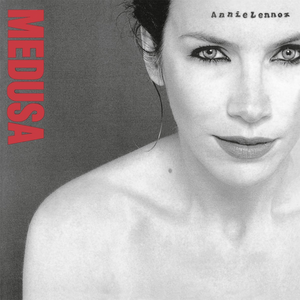
Medusa is the second solo studio album by Scottish singer Annie Lennox, released on 6 March 1995 by RCA Records. It consists entirely of cover songs. The album entered the UK Albums Chart at number one and peaked in the United States at number 11, spending 60 weeks on the Billboard 200. It has since achieved double platinum status in both the United Kingdom and the United States. As of 2018, Medusa had sold over six million copies worldwide.

"A Whiter Shade of Pale" is a song by the English rock band Procol Harum that was issued as their debut record on 12 May 1967. The single reached number 1 in the UK Singles Chart on 8 June and stayed there for six weeks. Without much promotion, it reached number 5 on the US Billboard Hot 100. One of the anthems of the 1967 Summer of Love, it is one of the most commercially successful singles in history, having sold more than 10 million copies worldwide. In the years since, "A Whiter Shade of Pale" has become an enduring classic, with more than 1,000 known cover versions by other artists.

"Why" is the debut solo single of Scottish singer-songwriter Annie Lennox, released on 16 March 1992. It was taken from her debut solo album, Diva (1992), and reached number five in the United Kingdom. In the United States, "Why" peaked at number 34 on the Billboard Hot 100 and number six on the Adult Contemporary chart. It was also a big hit internationally, reaching number one in Italy and peaking within the top 10 in Belgium, Canada, Ireland and five other countries. Its music video was directed by Sophie Muller. Stereogum ranked "Why" number one on their list of "The 10 Best Annie Lennox Songs" in 2015.
"Deep Purple" is a song and the biggest hit written by pianist Peter DeRose, who broadcast between 1923 and 1939 with May Singhi as "The Sweethearts of the Air" on the NBC radio network. The British rock band Deep Purple named themselves after the song.
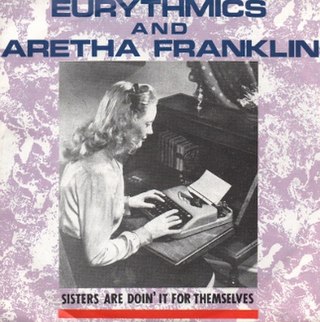
"Sisters Are Doin' It for Themselves" is a song by British pop duo Eurythmics and American singer Aretha Franklin. A modern feminist anthem, it was written by Eurythmics members Annie Lennox and David A. Stewart and featured on both Eurythmics' Be Yourself Tonight (1985) and Franklin's Who's Zoomin' Who? (1985) albums. The duo originally intended to perform with Tina Turner, who was unavailable at the time and so they flew to Detroit and recorded with Franklin instead. The track also features three of Tom Petty's Heartbreakers: Stan Lynch on drums, Benmont Tench on organ, and Mike Campbell on lead guitar, plus session bassist Nathan East.

"Sweet Dreams (Are Made of This)" is a song by British synth-pop duo Eurythmics. It was released as the fourth and final single from their second album of the same name in January 1983. It was their breakthrough hit, establishing the duo worldwide. It reached number two on the UK Singles Chart in March 1983, and number one on the US Billboard Hot 100 six months later; it was their first single released in the US.
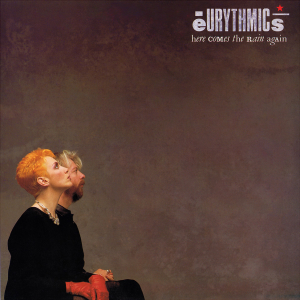
"Here Comes the Rain Again" is a 1983 song by British duo Eurythmics and the opening track from their third studio album Touch. It was written by group members Annie Lennox and David A. Stewart and produced by Stewart. The song was released on 12 January 1984 as the album's third single in the UK and in the United States as the first single.
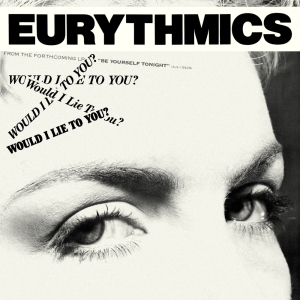
"Would I Lie to You?" is a song written and performed by British pop duo Eurythmics. Released on 9 April 1985 as the lead single from the band's fourth studio album, Be Yourself Tonight (1985), the song was the first by the duo to feature their change in musical direction from a predominantly synthpop style to rock and rhythm and blues. The song, and its accompanying album, featured a full backing band and relied less on electronic programming.

"I Need a Man" is a song recorded by British pop music duo Eurythmics. It was written by band members Annie Lennox and David A. Stewart and produced by Stewart. Taken from their sixth album, Savage (1987), the song was released in May 1988 by RCA Records as the third single in the UK and the first single in the United States.

"Step by Step" is a song recorded by Whitney Houston, originally written and recorded by Annie Lennox. The song appeared on the B-side to Lennox's 1992 single "Precious". Whitney Houston released a reworked crossover R&B/pop cover version in 1996 on the soundtrack to the film The Preacher's Wife. Houston's version replaces Lennox's verses with new lyrics and omits portions of the bridge. Annie Lennox provides backing vocals for Houston's rendition.

"Love Song for a Vampire" is a song composed and recorded by Scottish singer-songwriter Annie Lennox. It was recorded for Francis Ford Coppola's 1992 film, Bram Stoker's Dracula based on the 1897 gothic horror novel, where it plays during the end credits. Produced by Stephen Lipson, it was released in February 1993 by RCA and BMG as a double A-side with "Little Bird" in Ireland, the United Kingdom and several other countries in Europe. The single was a hit, peaking at number three on the UK and Irish Singles Charts. "Love Song for a Vampire" by itself reached number four in Spain and number ten in France. The music video for the song was directed by Sophie Muller, featuring footage from Bram Stoker's Dracula.

"Who Do You Love?" is a song written by American rock and roll pioneer Bo Diddley. Recorded in 1956, it is one of his most popular and enduring works. The song represents one of Bo Diddley's strongest lyrical efforts and uses a combination of hoodoo-type imagery and boasting. It is an upbeat rocker, but the original did not use the signature Bo Diddley beat rhythm.

"Put a Little Love in Your Heart" is a song originally performed in 1969 by Jackie DeShannon, who composed it with her brother Randy Myers and Jimmy Holiday. In the U.S., it was DeShannon's highest-charting hit, reaching number 4 on the Hot 100 in August 1969 and number 2 on the Adult Contemporary chart. In late 1969, the song reached number 1 on South Africa's hit parade. The song rivalled the success of her signature song, "What the World Needs Now Is Love".

"No More 'I Love You's'" is a song written by British musicians David Freeman and Joseph Hughes and recorded by them as the Lover Speaks. It was released in June 1986 as the lead single from their self-titled debut album. The song was covered by the Scottish singer Annie Lennox and became a commercial success for her in 1995, reaching number two on the UK Singles Chart.

"Little Bird" is a song composed and recorded by Scottish singer-songwriter Annie Lennox. Taken from her debut solo album, Diva (1992), it was produced by Stephen Lipson and released in February 1993 by RCA and BMG as a double A-side with "Love Song for a Vampire" in Ireland, the United Kingdom, and various other European countries. In other territories, "Little Bird" was released alone.

This article is the discography of the Scottish pop and rock singer-songwriter Annie Lennox. After a decade of major international success as part of Eurythmics, Lennox began her solo career in earnest in 1992 with the release of her first album Diva, which produced several hit singles including "Why" and "Walking on Broken Glass". The same year, she performed "Love Song for a Vampire" for Bram Stoker's Dracula. To date, she has released six solo studio albums, three of them being covers albums and a compilation album, The Annie Lennox Collection (2009).



















